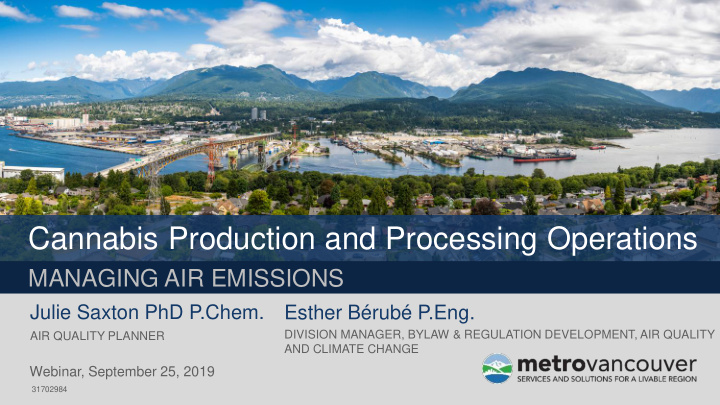



Cannabis Production and Processing Operations MANAGING AIR EMISSIONS Julie Saxton PhD P.Chem. Esther Bérubé P.Eng. DIVISION MANAGER, BYLAW & REGULATION DEVELOPMENT, AIR QUALITY AIR QUALITY PLANNER AND CLIMATE CHANGE Webinar, September 25, 2019 31702984
Potential Health and Volatile Organic Nitrogen Environmental Issues Dioxide Compounds Volatile organic compounds • Ground-level ozone formation sunlight, • Particulate matter formation heat • Odorous air contaminants Ground Level Ozone 2
Ground Level Ozone • More common in hot, sunny weather • Health effects • Eye, throat and nose irritation • Worsens lung and heart conditions • Environmental effects • Damages ecosystems and vegetation • Reduces crop yields • Damages buildings and materials 3
Example Emissions from Regional Crops 4
VOC Emissions Comparison Emissions of volatile organic compounds in the Canadian Lower Fraser Valley by sector compared to projected potential range of emissions from cannabis production in Metro Vancouver Fraser Valley Regional District (2015 emissions) Metro Vancouver (2015 emissions) Metro Vancouver (projected emissions) C.-T. Wang et al, 2019, Atmospheric Environment, 5 199, 80-87. C. Albee et al, Washoe 2015 Lower Fraser Valley Air Emissions Inventory and Forecast, March 2018 County Health District.
Reducing VOC Emissions • Regulated emissions • Specific industrial sites • Gasoline distribution • Industrial chemical product use • Infrastructure • Electric vehicle charging stations • Education and Outreach • Air quality advisories 6
Reducing VOC Emissions from Cannabis • Odour Management Policy Development Plan • Regional Ground-Level Ozone Strategy 7
Managing Air Contaminants Substances emitted into the air capable of • Injuring health or safety • Injuring property or any life form • Interfering with visibility • Interfering with the normal conduct of business • Causing material physical discomfort • Damaging the environment 8
Emission Management Approaches • Emissions released at the facility • Concentrations beyond the facility • Technology and management practices • Measurement, monitoring and reporting • Economic instruments 9
Emission Management for Cannabis Production • Emission Regulations • Agricultural Boilers • Site-specific Permits • Cannabis cultivation • Reciprocating engines 10
Developing a Regulation – Phase 1 May 2019 Summer 2019 From July 2018 February 2019 Winter 2019-20 Board Board Preliminary Public approves Discussion reviews issue consultation consultation consultation paper drafted analysis (phase 1) (phase 1) feedback 11
Developing a Regulation – Phase 2 Potential future steps Board Board reviews Board Public considers Proposals feedback approves consultation refined and directs bylaw consultation (phase 2) staff to draft (phase 2) adoption bylaw 12
Scope of Potential Regulation 13
Potential Regulation Measures controlling what is discharged: • Enclosing or containing key emissions sources 14
Potential Regulation Measures controlling what is discharged: • Enclosing or containing key emissions sources • Treating air with activated carbon 15
Potential Regulation Measures controlling what is discharged: • Enclosing or containing key emissions sources • Treating air with activated carbon • Limiting additional VOC sources 16
Potential Regulation Measures controlling how discharges can occur: • Preventing the release of fugitive or uncontrolled emissions 17
Potential Regulation Measures controlling how discharges can occur: • Preventing the release of fugitive or uncontrolled emissions • Minimizing risk during airshed air quality degradation 18
Potential Regulation Measures controlling how discharges can occur: • Preventing the release of fugitive or uncontrolled emissions • Minimizing risk during airshed air quality degradation • Preventing impacts near sensitive receptors 19
Supporting Provisions Measures providing evidence of effectiveness: • Approved emissions management plan • Monitoring for odorous air contaminants beyond property boundary • Compliance with other applicable regulatory requirements • Record keeping 20
Feedback Options • In person • Meetings • Site visits • Webinars • Online and printed questionnaires • Contact us at 604-432-6200 or AQBylaw@metrovancouver.org 21
Questions?
Recommend
More recommend